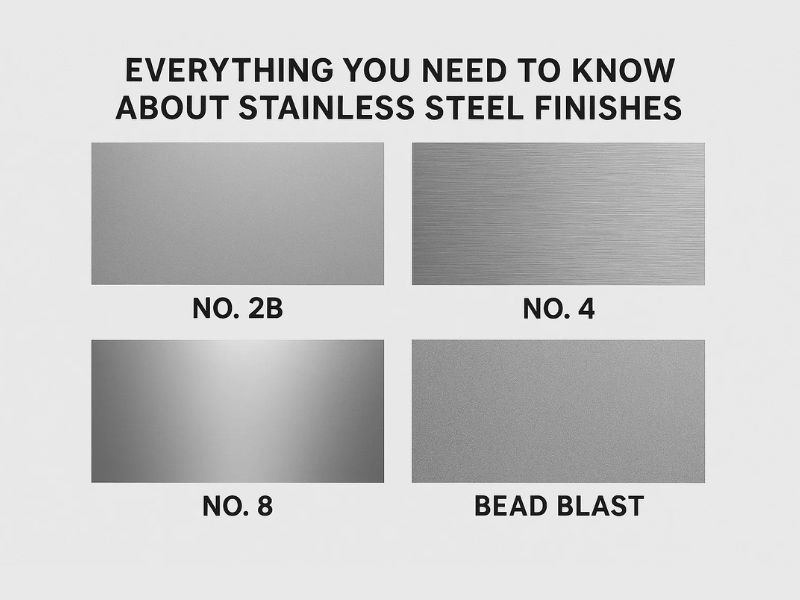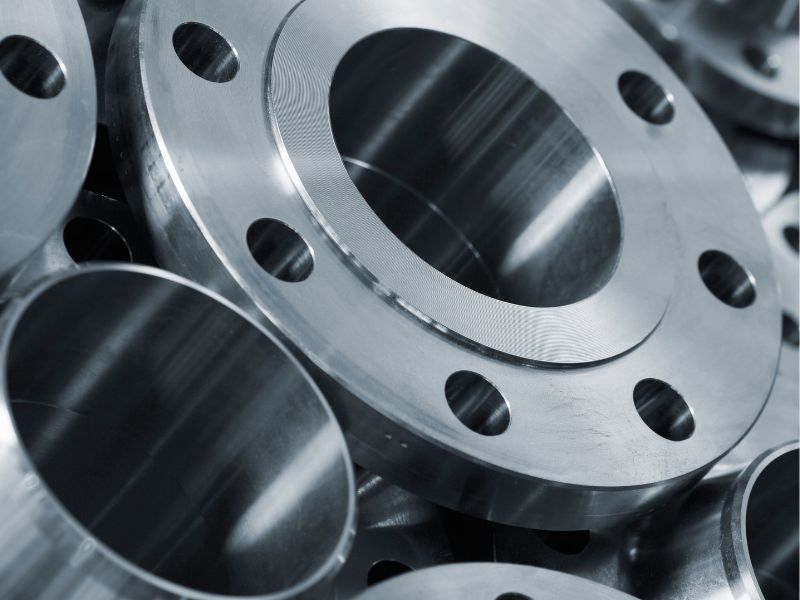- By Profab /
- September 16, 2025

Stainless steel finish is used a lot in a variety of applications. It is the last step done to the metal’s surface. This step changes how the metal looks and feels. You can pick matte, shiny, colored, or patterned styles. Each style gives a different look and works in its own way. The finish keeps the metal safe and helps it last longer. This article will analyze stainless steel finishes ranging from industrial-grade to mirror finishes.
Table of Contents
What Is a Stainless Steel Finishes
Stainless steel finishes is a fabrication method intended to improve the metal’s performance. It is a key step that determines everything from corrosion and wear resistance to electrical conductivity and weldability. A crucial aspect of understanding a stainless steel finish is recognizing the role of surface roughness. This metric, often measured as Ra (Average Roughness) in North America or Rz (mean roughness depth) in Europe, quantifies the texture of a surface.
Types of Stainless Steel Finishes

Choosing the right stainless steel finish helps you get the look and performance you want. Each finish offers unique benefits for different spaces and uses.
Mill Finishes
Mill finishes represent the most basic and fundamental categories of stainless steel finishes. It is produced directly from the rolling and annealing processes. It is the starting point for all other finishes.
No.1 Finish(1D)
The No.1 finish removes the dark scale formed during heat treatment by hot rolling, annealing, and acid pickling. This process results in a dull, non-reflective, and uneven surface. With a high surface roughness (Ra from 3.0-7.5µm), this finish is not aesthetically appealing. The No.1 finish works well in factories, tanks, and places where appearance does not matter. Common uses include furnace parts, heat exchangers, and other non-decorative construction purposes. You get a tough surface that handles harsh conditions.
2B Finish
The 2B stainless steel surface finish is the most common and versatile of the mill finishes. It is produced by cold rolling, followed by annealing and pickling, and then a final light temper pass with polished rolls. This final rolling gives the surface a smooth, moderately reflective, and slightly shiny appearance with excellent flatness control. With a surface roughness (Ra) typically ranging from 0.1-0.8µm. It is significantly smoother and brighter than the 2D finish.
The 2B finish is widely used in cookware, small tanks, food processing equipment, and pharmaceutical machinery due to its balance of durability, hygiene, and affordability.
The versatility of the 2B finish lies in its dual nature: it is bright enough for many general-purpose applications while also serving as the ideal starting point for mechanically polished finishes like No. 3 and No. 4.
No. 2D Finish
The 2D finish stainless steel is a smooth, non-reflective, and dull surface. It is created by cold rolling, annealing, and pickling. The 2D finish does not undergo a final pass with polished rolls like the No.2B finish.
That is why it looks darker and less reflective. Its appearance is similar to a No.1 finish but with a smoother texture.
A key functional advantage of the 2D finish is its non-directional nature, which allows it to retain lubricants in deep drawing applications. This property makes it an ideal
finish for stainless steel components that must be formed into complex shapes. Applications for this finish include auto exhaust components, chemical processing machinery, and refinery equipment.
Polished Finishes
Mechanical polishing forms the second major category of stainless finishes. Craftsmen abrade the surface using various grit abrasives. The result ranges from satin to mirror-like brilliance and adds functional benefits.
No. 3 Finish
The No.3 stainless steel finish is produced by directionally wet-polishing a No.2B surface with a coarse abrasive belt. The typical abrasive grit range is 100–120. The result is a satin, matte appearance with a linear grain. Surface roughness for this finish typically exceeds 1.0 µm. No.3 is used for food processing equipment, laboratory apparatus, and architectural applications that need a coarse brushed finish.
No. 4 Finish
The No.4 finish is the most widely recognized stainless finish. It is made by directional wet-polishing using finer 120–180 grit. The process yields a smoother, brighter, slightly reflective surface. Very fine parallel lines appear across the finish. Typical Ra values range from 0.2 to 1.0 µm. It is used in elevators, kitchen sinks, restaurant equipment, and architectural panels.
No. 5 Finish (Satin/Brushed)
Also known as EN 2K, this brushed finish is made with a series of abrasives. It creates a uniform, matte texture with fine parallel lines. Its slightly rougher surface resists scratches and abrasion. Common uses include cladding, handrails, and signage. It offers a practical balance of durability and aesthetics.
No. 6 Finish (Dull Satin)
The EN 1K-2K finish is produced by Tampico brushing a No.4 surface. It creates a non-directional, dull satin look that is smoother and less reflective. Once popular in late 20th-century architecture, it now appears mainly on statues and ornaments.
No. 7 Finish
Buffing a finely ground surface creates this finish. The result is a high-luster, near mirror appearance. It may still show faint grit lines from grinding. It is used mainly for ornamental and architectural features like column covers and decorative wall panels.
#8 Mirror Finish
The No.8 finish is the most reflective stainless finish by ASTM standards. It is produced by polishing with progressively finer abrasive grits. Extensive buffing follows to create a smooth, mirror-like surface. Under close inspection, faint buff lines may still appear. This elegant finish suits signage, reflectors, and architectural sculptures. Notably, it was used on Chicago’s Cloud Gate, the “Bean”.
Comparison of Stainless Steel Finishes
Surface Roughness (Ra) for Hygiene
For many applications, surface roughness (Ra) is more critical than appearance. In food processing, pharmaceuticals, and medical devices, finish on stainless steel helps prevent contamination. These sectors require non-porous, easy-to-clean surfaces to stop bacteria growth. A low Ra value indicates higher cleanability. For example, a stainless steel 2B finish with 0.1–0.8µm roughness is easier to sanitize than a rough No.1 finish. Microscopic valleys on rough surfaces trap contaminants, even after harsh cleaning. That is why sanitary industries demand low Ra finishes to meet safety and regulatory standards.
The following table provides a comprehensive stainless steel surface finish chart. It compares the most common finishes across key attributes.
Finish Name (ASTM & EN) | Production Method | Appearance/Aesthetic | Typical Ra Value (µm) | Primary Advantages | Common Applications |
No. 1 (1D) | Hot-rolled, annealed, pickled | Dull, non-reflective, rough | 3.0-7.5 | Durable, low cost, high temperature use | Industrial, furnace parts, heat exchangers |
No. 2D (2D) | Cold-rolled, annealed, pickled | Smooth, non-reflective, dull | 0.2-0.8 | Ideal for deep drawing, retains lubricants | Chemical equipment, car exhausts |
No. 2B (2B) | Cold-rolled, annealed, pickled, temper passed | Smooth, moderately reflective, slightly shiny | 0.1-0.8 | Versatile, cost-effective, good hygiene | Food processing, cookware, pharmaceutical machinery |
BA (2R) | Cold-rolled, bright annealed | Smooth, bright, mirror-like | 0.05-0.1 | High reflectivity without polishing, good hygiene | Surgical instruments, trim appliances, traffic mirrors |
No. 3 (1G-2G) | Directionally wet-polished (100-120 grit) | Satin, matte, with linear grain | >1.0 | Good aesthetics, cleanable | Food processing, brewery equipment, architecture |
No. 4 (1J-2J) | Directionally wet-polished (120-180 grit) | Smoother, brighter, with fine lines | 0.2-1.0 | Most popular, cleanable, aesthetic | Kitchen sinks, elevators, restaurant equipment, appliances |
No. 5 (2K) | Directionally wet-polished (series of abrasives) | Matte, non-reflective, parallel lines | 0.5-0.8 | Scratch resistant, durable | Architectural cladding, handrails |
No. 6 (1K-2K) | Tampico brushed on a No. 4 finish | Soft, dull, satin, non-directional | <0.5 | Unique aesthetic, less common today | Statues, architectural accents |
No. 7 | Buffed on a finely ground surface | High-luster, nearly mirror-like | Not standardized | Highly reflective, ornamental | Column covers, ornamental trim |
No. 8 | Polished with progressively finer abrasives, then buffed | Highly reflective, mirror finish | Not standardized | Ultimate aesthetic, pristine reflection | Signs, reflectors, wall panels, sculpture |
Long-Term Maintenance and Care
The maintenance needs of stainless steel depend on its finish. All finishes benefit from routine cleaning, but some require extra care. Directional finishes like No.4 should be cleaned along the grain to prevent damage. In contrast, smooth, non-directional finishes like No.8 are more forgiving. Long-term performance and appearance depend heavily on following the proper maintenance practices throughout the product’s lifespan.
Custom Finishes
For advanced applications, standard finishes may not be enough. Engineers and designers often specify custom stainless steel finishes to meet unique needs. These may require precise Ra or Rz values to achieve exact performance. Such finishes are common in sensitive products, including superconductor components and medical implants, where reliability and precision are critical.
The Economics of Stainless Steel Finishes
Cost control is a central factor in stainless steel procurement. Mill finishes like No.2B are usually more economical upfront. However, the lowest purchase price does not always mean the lowest lifecycle cost. Cheaper, less hygienic finishes may corrode faster, require more maintenance, or fail sooner. A professional approach considers total lifetime cost. Highly polished finishes are easier to clean and more resistant to contaminants. They can save money by reducing maintenance, avoiding downtime, and extending service life. This holistic view ensures both short-term savings and long-term durability.
Conclusion
From the rugged No.1 finish in industrial settings to the mirror brilliance of the No.8 finish, every stainless steel surface offers distinct advantages. The best results come when the selected finish aligns with the environment, function, and maintenance needs. By understanding corrosion resistance, production methods, and lifecycle costs, Profab Machine helps clients make informed choices. As an experienced stainless steel fabricator, it ensures each project achieves long-term durability and reliable performance.
FAQ
What is the best stainless steel finish for outdoor use?
You want a finish that resists rust and weather. The bead blast finish and No.1 finish work well outside. These finishes handle rain, sun, and pollution. You get a strong surface that lasts in tough conditions.
Which stainless steel finish hides fingerprints best?
Brushed and satin finishes hide fingerprints and smudges. You see fewer marks in busy places like kitchens and elevators. These finishes have a soft texture that helps keep surfaces looking clean.
Can you mix different stainless steel finishes in one project?
Yes, you can mix finishes for style and function. Use mirror finishes for highlights and brushed finishes for busy areas.
Send Inquiry Now
Related Resource
